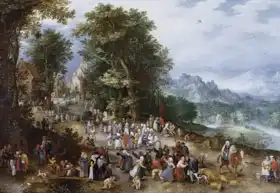About this finishing
Print. The image is printed on the top quality 10-ink HP Z9PS printer on HP matte 270 g / m2 paper. You can choose any size to an accuracy of 1 cm. A margin of 5 cm around the image is added to the size of the motif.


You can find a detailed description about our finishings
here.
Flemish feast
Date:
1600Medium:
oil on cooperLocation:
Hampton Court Palace, Royal Collection Trust, LondonDimensions:
68.6 x 47.6
In this beautiful landscape,
Jan Brueghel the Elder depicts a celebration during which people celebrate a religious festival in the form of an outdoor social event. The picture captures the inexhaustible palette of human life, whose stories can be read endlessly. In the background we can see a procession entering the temple, and on the left a pub around which a large number of people are moving. In the central part, peasants dance in a circle to the sound of bagpipes, and a pair of children to the right of a large dancing group learn to imitate the dance movements of adults. A number of very authentic people appear in the picture, whose occupations we can easily guess - a toy seller, a beggar, members of the upper class or a pig herder. The painting is supposed to represent human hope at the end of the war and trust in the new Archduke Albrecht VII. Habsburg and his wife Isabel. In later similar works, the archduke is depicted directly in the paintings, watching the celebrations of the common people with a kind face.
Brueghel painted picture Flemish feast in 1600. Prevailing color of this fine art print is vivid and its shape is landscape. Original size is 68.6 x 47.6. This art piece is located in Hampton Court Palace, Royal Collection Trust, London. This image is printed on demand - you can choose material, size and finishing.
Jan Brueghel the Elder (1568-1625). Flemish painter. Son of
Pieter Brueghel the Elder and father of
Jan Brueghel the Younger. He is famous for his still life paintings with flowers (one of them can even be found in Prague). For his favourite theme, he is called "flowery" Brueghel, and possibly for his favourite material, he is also called "velvety." Unlike his brother
Pieter Brueghel the Younger, he developed a personalized and nuanced style of painting, distinct from his father’s. Many of his paintings originated through collaborations with other artists (for example, he painted figures into other artist’s landscapes and vice versa).


